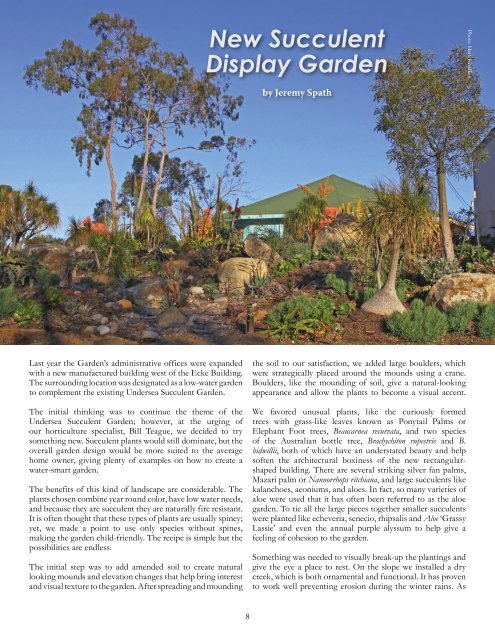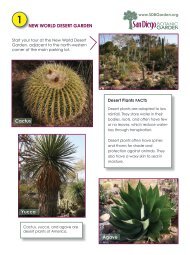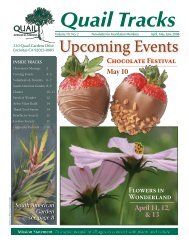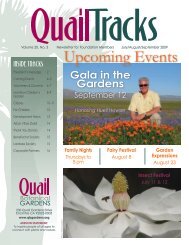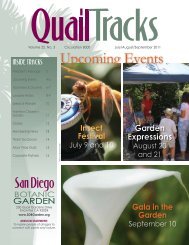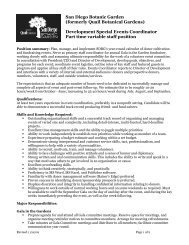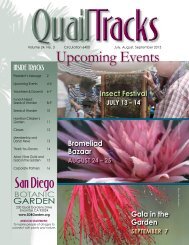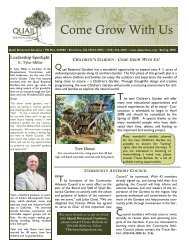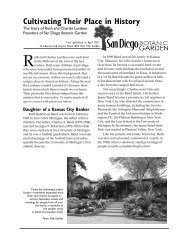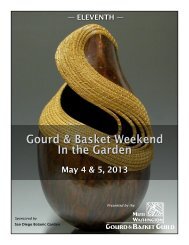Upcoming Events - San Diego Botanic Garden
Upcoming Events - San Diego Botanic Garden
Upcoming Events - San Diego Botanic Garden
You also want an ePaper? Increase the reach of your titles
YUMPU automatically turns print PDFs into web optimized ePapers that Google loves.
New Succulent<br />
Display <strong>Garden</strong><br />
Photo: Herb Knufken<br />
by Jeremy Spath<br />
Last year the <strong>Garden</strong>’s administrative offices were expanded<br />
with a new manufactured building west of the Ecke Building.<br />
The surrounding location was designated as a low-water garden<br />
to complement the existing Undersea Succulent <strong>Garden</strong>.<br />
The initial thinking was to continue the theme of the<br />
Undersea Succulent <strong>Garden</strong>; however, at the urging of<br />
our horticulture specialist, Bill Teague, we decided to try<br />
something new. Succulent plants would still dominate, but the<br />
overall garden design would be more suited to the average<br />
home owner, giving plenty of examples on how to create a<br />
water-smart garden.<br />
The benefits of this kind of landscape are considerable. The<br />
plants chosen combine year round color, have low water needs,<br />
and because they are succulent they are naturally fire resistant.<br />
It is often thought that these types of plants are usually spiney;<br />
yet, we made a point to use only species without spines,<br />
making the garden child-friendly. The recipe is simple but the<br />
possibilities are endless.<br />
The initial step was to add amended soil to create natural<br />
looking mounds and elevation changes that help bring interest<br />
and visual texture to the garden. After spreading and mounding<br />
the soil to our satisfaction, we added large boulders, which<br />
were strategically placed around the mounds using a crane.<br />
Boulders, like the mounding of soil, give a natural-looking<br />
appearance and allow the plants to become a visual accent.<br />
We favored unusual plants, like the curiously formed<br />
trees with grass-like leaves known as Ponytail Palms or<br />
Elephant Foot trees, Beaucarnea recurvata, and two species<br />
of the Australian bottle tree, Brachychiton rupestris and B.<br />
bidwillii, both of which have an understated beauty and help<br />
soften the architectural boxiness of the new rectangularshaped<br />
building. There are several striking silver fan palms,<br />
Mazari palm or Nannorrhops ritchiana, and large succulents like<br />
kalanchoes, aeoniums, and aloes. In fact, so many varieties of<br />
aloe were used that it has often been referred to as the aloe<br />
garden. To tie all the large pieces together smaller succulents<br />
were planted like echeveria, senecio, rhipsalis and Aloe ‘Grassy<br />
Lassie’ and even the annual purple alyssum to help give a<br />
feeling of cohesion to the garden.<br />
Something was needed to visually break-up the plantings and<br />
give the eye a place to rest. On the slope we installed a dry<br />
creek, which is both ornamental and functional. It has proven<br />
to work well preventing erosion during the winter rains. As<br />
8


